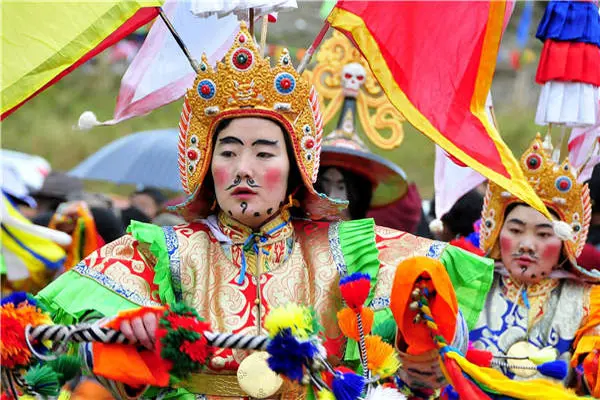Performers play King Gesar at a festival in Dege country. Sichuan province, which the legend describes as the king's hometown. (Photo / Wu Guangyu, Xinhua)
(CHINADAILY)Preservation of the masterpiece of ancient Tibetan culture, The Epic of King Gesar, is facing challenges on two fronts: The region's wizened storytellers are taking their treasures to the grave even as the younger generation is focused on contemporary entertainment.
"The epic is under constant onslaught from globalization and modernization," said Tsering Phuntsok, director of the Ethnic Institute of the Tibet Academy of Social Sciences, who has been leading preservation efforts in the Tibet autonomous region.
The King Gesar story of good vanquishing evil was transmitted orally from generation to generation over a millennium. Today, it's much less popular, quickly losing ground to the many activities of modern life on the plateau, known as the "roof of the world".
"The emergence of much modern technology has provided Tibetans more options on amusements, but it also has had an impact on the traditional way of transmitting the heritage, which is mainly transmitted orally," Tsering said.
"Both the governments and insiders have been valuing preservation, rather than studies, in the past few decades, because of its importance to Tibetan folk culture," he said.
An office dedicated to preserving the epic was opened in 1979, according to the Tibet Academy of Social Sciences. Starting in the 1980s, Tibet carried out a survey on the epic's many iterations, seeking storytellers, and collecting old manuscripts and woodblock printing versions of the saga, said Tsering, 50.
More than 74 old manuscripts were collected, and within a couple of years, the office had identified 39 storytellers who could each recount more than 10 of the King Gesar tales. The epic's narrators were mainly found in Tibet's northern Nagqu prefecture, eastern Qamdo prefecture and western Ngari prefecture.
Since then, more than 57 storytellers have been identified and their tales have been preserved in print, and on audio recordings and video. More than 5,000 hours of audio recordings were collected and many of the stories have been rendered into books. A collection of King Gesar tales performed by 10 eminent storytellers from Tibet is expected to be published this year.
Another project, the Gesar Music Collection, which Tsering directed, also has been completed. The first of its kind and 11 hours in length, it consists of five videos and features 118 tunes sung in the voices of 76 of the epic's characters. Six pre-eminent King Gesar artists of Tibet's Nagqu prefecture were selected as performers.
"Nagqu is a place with the richest tunes for King Gesar," Tsering said.
Among the preservationist's proudest achievements is a collection of tales recorded by Samdrub, a legend among King Gesar storytellers, who died in 2011.
Recognized as the most complete collection of an individual storyteller's catalog in Tibet, Samdrub's King Gesar stories are amassed in 45 unbound manuscripts. They have more than 500,000 lines, much longer than the lauded Mahabharata, the epic Sanskrit poem of ancient India, which has 200,000 verses.
Tsering has spent 16 years working to make the collection readable, listenable, and available for later generations.
Interest in The Epic of King Gesar is a global affair. National and international seminars on King Gesar studies have been held in China for many years. Tibet was the host of the National Seminar on King Gesar Studies in 2009. The seventh International Seminar on King Gesar was held in Sichuan province last September.
In addition to international seminars, workshops on King Gesar have been held in Qinghai's prefectures of Golok and Yushul, Gansu's Machu county, and Sichuan's Garze prefecture.
The Epic of King Gesar is sung widely throughout Central Asia, and has been found among China's ethnic groups of Tibetan, Mongolian, Bai, Naxi, Pumi, Lisu, and Yugur peoples, and in Bhutan, Nepal, Mongolia, Pakistan, India and Russia.
The epic was listed as a World Intangible Cultural Heritage item by UNESCO in 2009.
"Making documentaries of other King Gesar storytellers is the key work my team will tackle next as other storytellers have asked us to record their songs," Tsering said. "Besides translating the collected epics into Chinese, English is our next big plan."
 简体中文
简体中文

